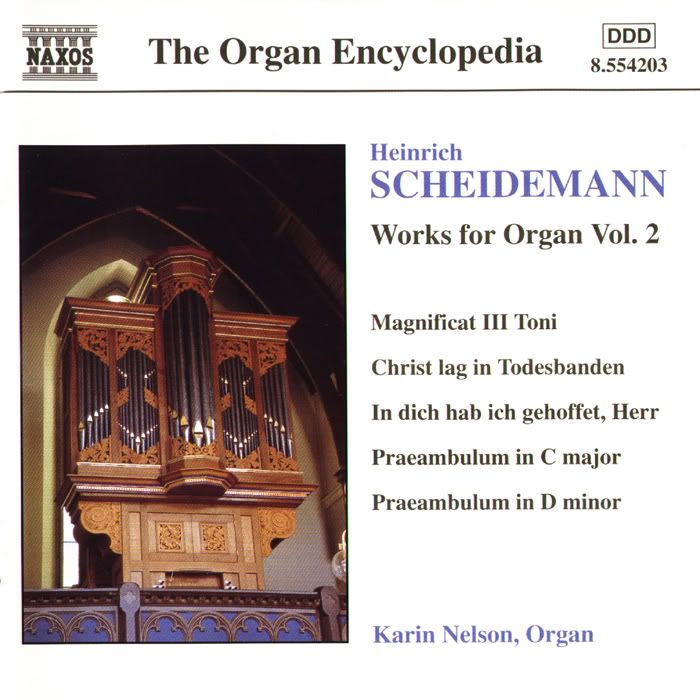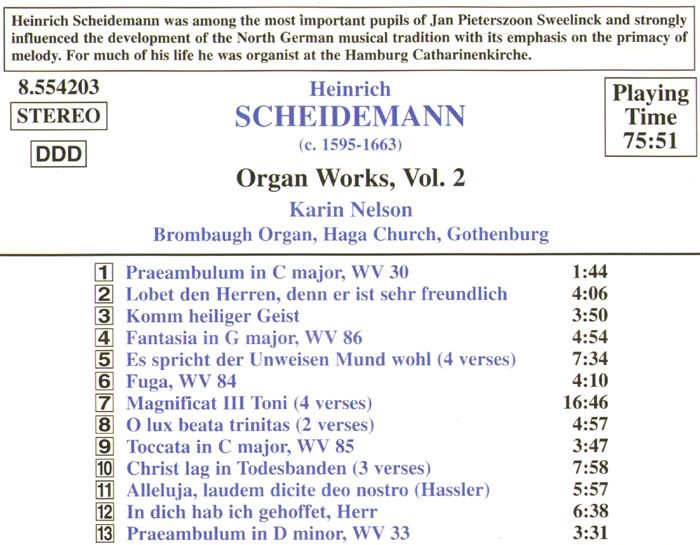 |
|
Heinrich Scheidemann (1595 - 1663)
Organ Works, Vol.2
Label: Naxos, 8.554203
Year: 1999
Performer:
Karin Nelson - organ
Tracklist:
01. Praeambulum in C major, WV 30
02. Lobet den Herren, denn er ist sehr freundlich
03. Komm heiliger Geist
04. Fantasia in G major, WV 86
05. Es spricht der Unweisen Mund wohl
06. Fuga, WV 84
07. Magnificat III Toni
08. O lux beata trinitas
09. Toccata in C major, WV 85
10. Christ lag in Todesbanden
11. Alleluja, laudem dicite deo nostro
12. In dich hab ich gehoffet, Herr
13. Praeambulum in D minor, WV 33
Total Playing Time: 01:15:48
Heinrich Scheidemann was born in about 1595 in Wohrden, Holstein where his father David was organist. By 1604 the family had moved to Hamburg, when David Scheidemann became the organist of Catharinen-kirche. During the seventeenth century Hanseatic Hamburg was a thriving town with a strong economy and a flourishing culture. The town's location close to the river Elbe and the different seas made it ideal for merchants from a variety of ports. Organists were highly esteemed in these prosperous times, and the Scheidemann family surely benefited from the city's goodwill. Young Heinrich must have impressed the congregation's elders directly, as from 1611 to 1614 the parish of the Catharinenkirche supported Heinrich during his studies with Jan Pieterszoon Sweelinck in Amsterdam. Not much else is known about Heinrich Scheidemann until 1629, when he succeeded his father as organist at the Catharinenkirche, serving also as clerk for the congregation. A further indication of the organist's high status was the congregation's arrangement with the city to exempt Scheidemann from taxes and from conscription. He enjoyed a considerable reputation as an organist, composer and teacher during his lifetime, and his students included his successor Johann Adam Reinken and Jacob Lorentz, the grandson of Scheidemann's colleague Jacob Praetorius. He died in 1663, probably a victim of the plague that ravaged Hamburg during this period.
A large part of Scheidemann's music was unknown until the 1950s, when important documents were discovered by Gustav Pock in the Calvorschen Bibliotek at Clausthal-Zellerfeld, Germany. As a result of this discovery, Scheidemann' s work was revealed as the largest surviving body of composition from among the students of Sweelinck. Sweelinck's influence is obvious in the music of Scheidemann, particularly in the virtuoso clavier-style inspired by the English virginalists and the vocal Italian style. Scheidemann combined these ideas with newer elements, inspired by the large North German organs, as, for example, the four-manual organ at the Catharinenkirche, rebuilt and extended during the period of Scheidemann's tenure.
One new stylistic element was Scheidemann's method of lifting out an ornamented solo-voice on one manual, with continuo accompaniment by two voices on another manual and a third in the pedal. Another new element typical to Scheidemann was the use of echo effects between the various manuals, directly reflecting the larger organ of Catharinenkirche relative to Sweelinck's organ in the Oudekerk in Amsterdam.
Scheidemann's organ-music can be divided into two categories: freely composed works, and compositions based on a melody or cantus firmus. On this recording the two Praeambula, the Toccata, Fantasy and Fugue can be placed in the first group, although probably the Toccata and Fantasy were intended originally for harpsichord. The other pieces on the recording are based on a cantus firmus. The two verses of Lobet den Herren, denn er ist sehr freundlich were composed together, although they are, in fact, two individual variations. The piece starts as a normal four--part chorale with an ornamented melody. As the piece progresses the concept changes, coloured with echos and toccata passages in a more virtuoso style. The original idea with the ornamented cantus firmus recurs as the piece ends in the style it started.
During the seventeenth century in Hamburg the hymn Komm, Heiliger Geist, Herre Gott opened the weekly services. In this chorale setting Scheidemann once more uses the idea of an ornamented cantus firmus but, before each phrase of the ornamented solo voice, the same phrase in its simple form is used in the pedal as the foundation for the interlude.
The organ Magnificats probably were performed in alternatim with the choir during the Vesper services. In the first and fourth verse of Magnificat III Toni one can clearly hear the melody in the bass. In the two middle verses Scheidemann presents the cantus firmus in different voices and styles, sometimes as an ornamented melody or other times concealed within the polyphony.
As with the Magnificats, the hymn O lux beata trinitas was also used in the Vesper service. In the first verse the melody occurs in the bass voice and in the second verse in the soprano. In the first verse of Christ lag in Todesbanden, after an imitative introduction, the melody appears in the bass. The second verse is written for two manuals and pedal. The left hand and pedal are the harmonic foundation for the solo in the right hand. The first phrase of the melody is unembellished, while in the others the melody is more or less hidden within a musical string of pearls. The third verse is a duo, a common form in the sixteenth and seventeenth centuries as a reaction to polyphonic music. The cantus firmus is in long note values in the upper voice, contrasted by the moving bass line. Another duo is found in the second verse of Es spricht der Unweisen Mund wohl.
The motet-tabulation based on Hassler's motet Alleluja, laudem dicite Dea nostro was probably used in the service when the boys' choir, the Kantorei, was absent. The organist was required to 'substitute' for the choir when they were appearing in one of the city's other churches.
The variation over the hymn In dich hab ich gehoffet, Herr is written for two manuals without pedal, with the melody appearing in both the soprano and the bass. Echo passages abound, reminding the listener of Sweelinck's echo fantasies. The closing measures are identical to the last bars of a work by Scheidemann's contemporary Andreas Duben, Wo Gott der Herr nicht bei uns halt.
Scheidemann was clearly inspired by Sweelinck, and he bequeathed this inspiration to the next generation of organ composers, together with his own 'Scheidemannesque sweetness', to use the words of Mattheson. Many of Scheidemann's musical ideas prevailed well into the eighteenth century, inspiring the compositions of famous organists such as Reinken, Buxtehude and Each.


| SPOILER (LOG FILE) |